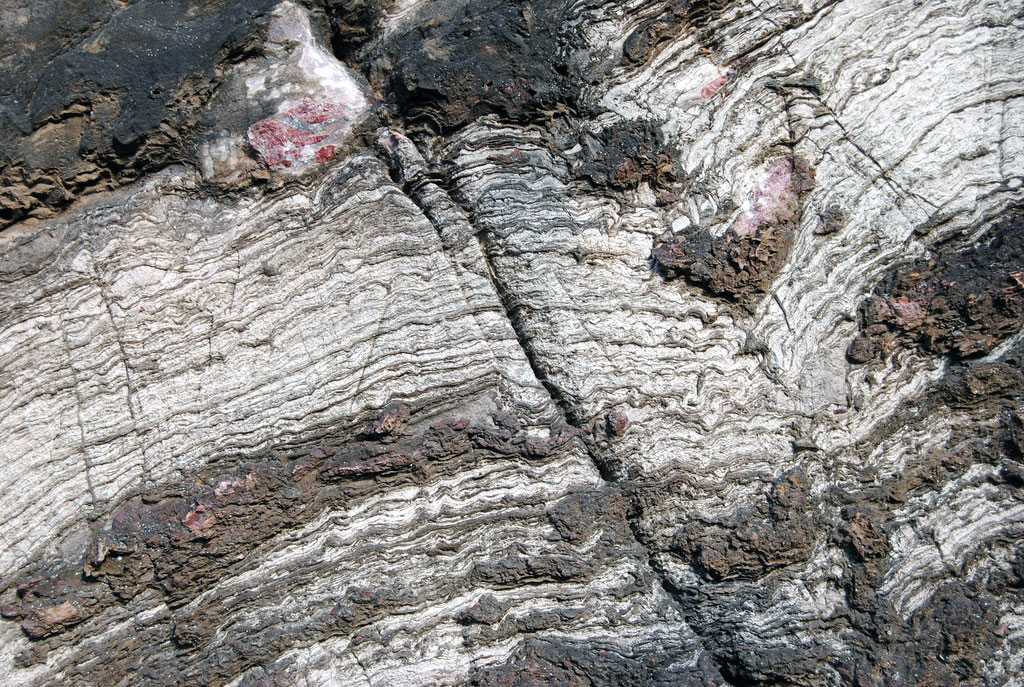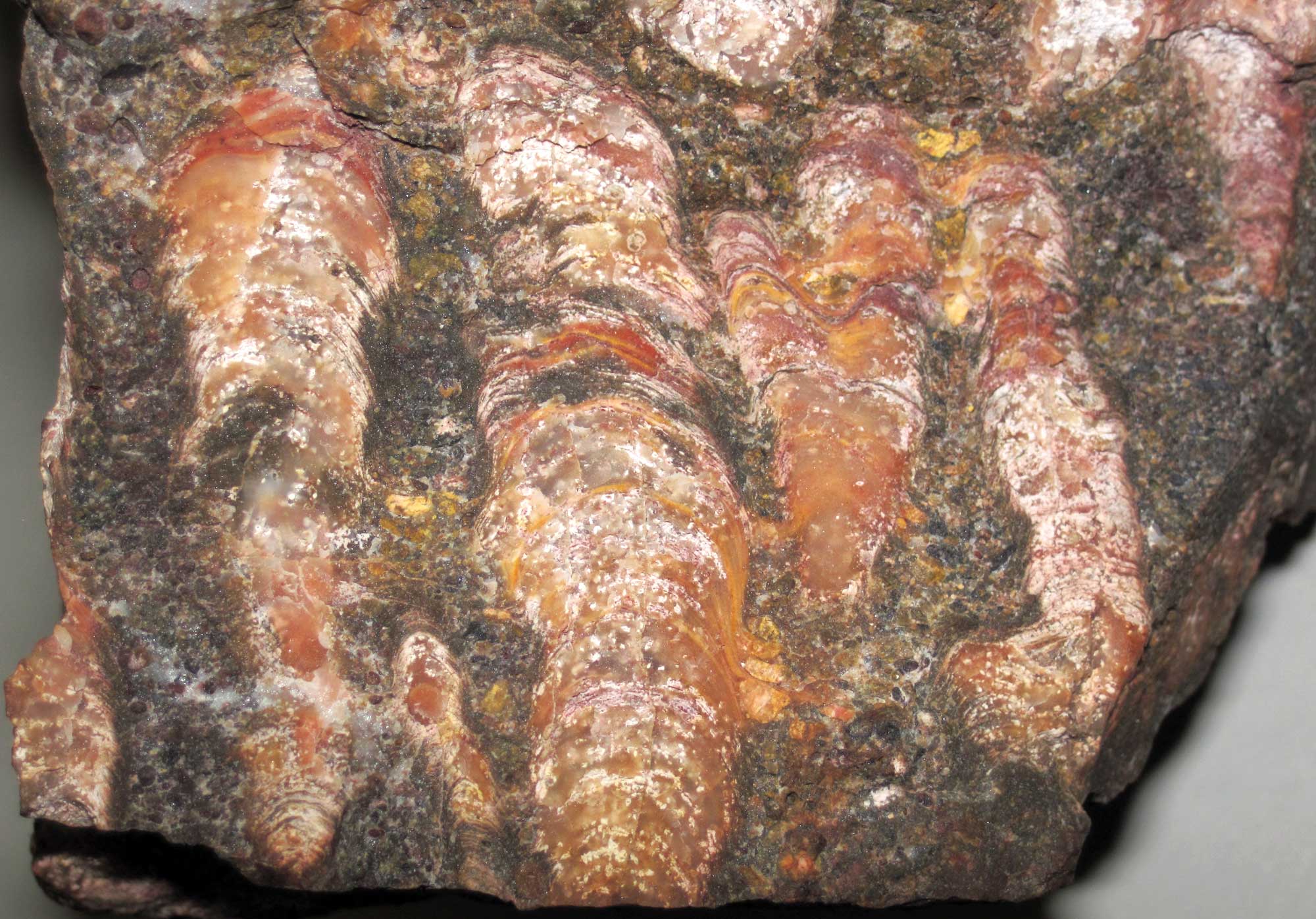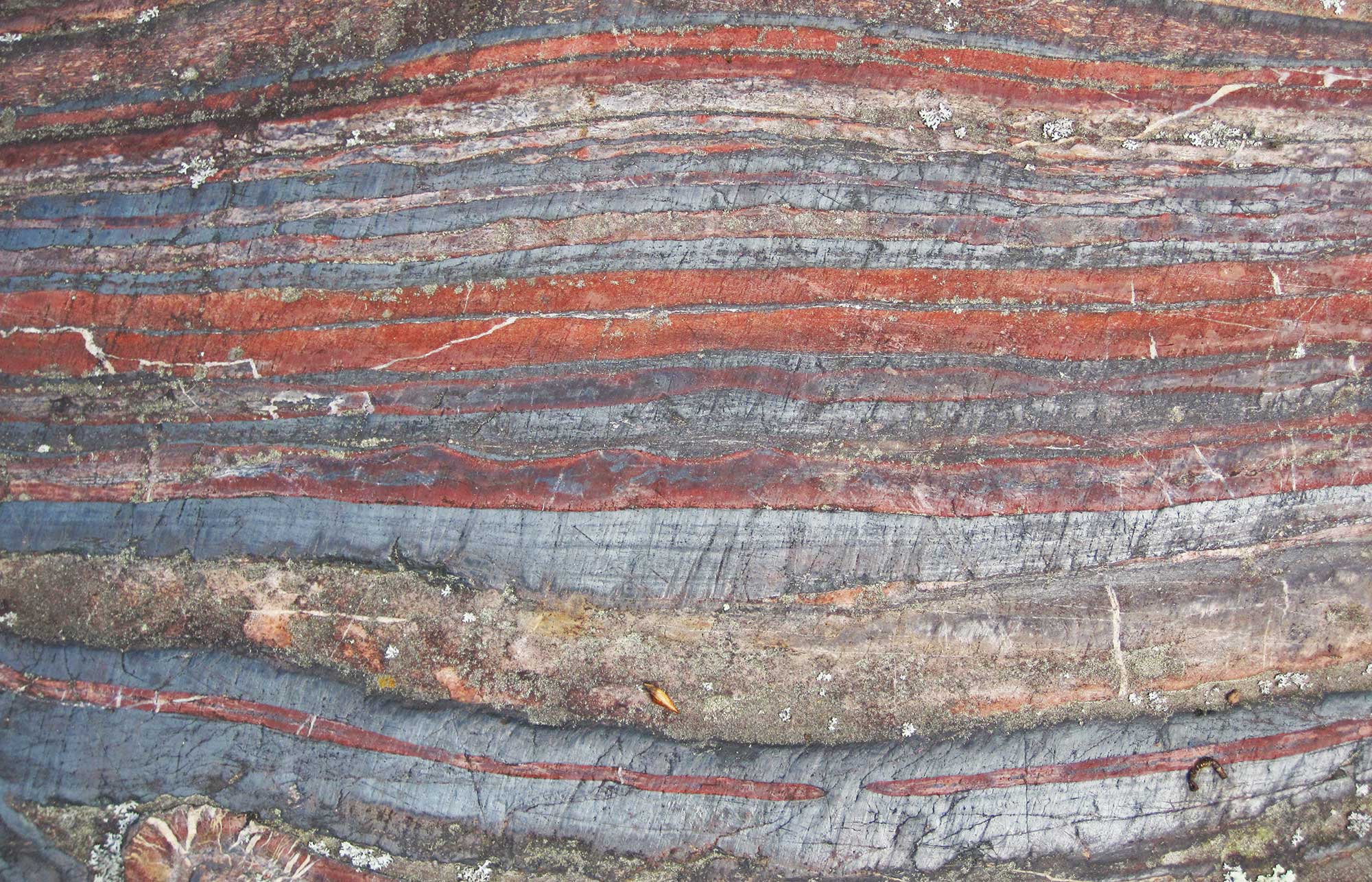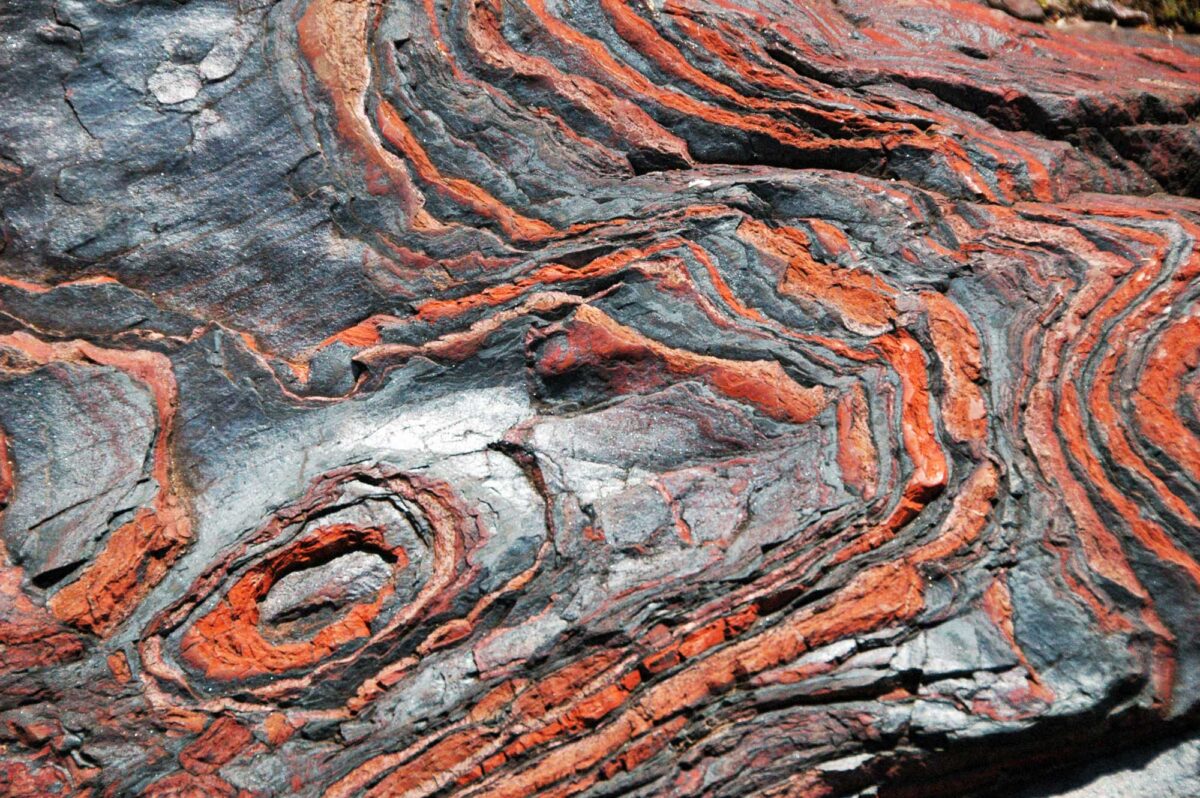Page snapshot: Introduction to the fossils of the Superior Upland region of the midwestern United States.
Topics covered on this page: Precambrian fossils; Stromatolites; Grypania spiralis; Banded iron formations; Resources.
Credits: Most of the text of this page is derived from "Fossils of the Midwestern US" by Alex F. Wall and Warren D. Allmon, chapter 3 in The Teacher-Friendly Guide to the Earth Science of the Midwestern U.S., edited by Mark D. Lucas, Robert M. Ross, and Andrielle N. Swaby (published in 2014 by the Paleontological Research Institution; currently out of print). The book was adapted for the web by Elizabeth J. Hermsen and Jonathan R. Hendricks in 2022. Changes include formatting and revisions to the text and images. Credits for individual images are given in figure captions.
Updates: Page last updated September 22, 2022.
Image above: Banded iron formation, Paleoproterozoic, Negaunee Iron Formation, Michigan. Photo by James St. John (flickr, Creative Commons Attribution 2.0 Generic license, image resized).
Precambrian fossils
The Superior Upland region of the Midwest contains the largest surface exposure of North America’s ancient core, the Canadian Shield. The shield is composed almost entirely of metamorphic rock that is 1.6 to 2.6 billion years old. Its composition would normally preclude it from containing fossils, as the heat and pressure associated with metamorphism would typically destroy any original fossil remains, but this region contains significant evidence of ancient life!
Stromatolites
Stromatolites provide some of the earliest direct fossil evidence for life on Earth, and they can be found in northern Minnesota and Michigan’s Upper Peninsula. Stromatolites are formed by mats of single-celled cyanobacteria (sometimes called "blue-green algae"). As the bacteria reproduce, new generations form new layers on top of the older mats, also trapping sediment. After many generations, the layers form a dome above the surface of the seafloor. The sediment stuck in these structures makes them fairly robust and easily preserved.

Stromatolites, Paleoproterozoic Kona Dolomite, Upper Peninsula, Michigan. Photo by James St. John (flickr, Creative Commons Attribution 2.0 Generic license, image resized).

Stromatolites, Paleoproterozoic Biwabik Iron Formation, northeastern Minnesota. Photo by James St. John (flickr, Creative Commons Attribution 2.0 Generic license, image resized).
Grypania spiralis
The Upper Peninsula of Michigan is home to fossils of Grypania spiralis, which many experts think may be filaments of algae. Grypania appears as spirals on rock that is about 2.1 billion years old. These fossils could be the oldest examples of multicellular organisms and among the first evidence of eukaryotes.
Before eukaryotes evolved, all life consisted of single-celled, prokaryotic organisms. Prokaryotes, which includeo bacteria, are often small cells that lack organelles (membrane-bound subcellular structures). If Grypania is indeed the first eukaryote, it is a very early relative of all modern complex organsisms: plants, fungi, animals, and protists.

A possible alga (Grypania spiralis) from the Paleoproterozoic Negaunee Iron Formation, Upper Peninsula, Michigan. Photo by James St. John (flickr, Creative Commons Attribution 2.0 Generic license, image cropped and resized).
Banded iron formations
One of the most interesting types of rock in the Superior Upland region is banded iron formation. Banded iron formations consist of repeated, thin layers (a few millimeters to a few centimeters in thickness) of silver to black rock that alternative with red layers of similar thickness. The silver to black layers consist of iron oxides, either magnetite (Fe3O4) or hematite (Fe2O3). The red layers consist of iron-poor shales and cherts that contain thin layers of iron oxides. Although banded iron formations are not fossils in the strictest sense, they are important evidence for the existence of Precambrian life. This is because iron oxides can only form in the presence of oxygen.
Oceans on the early Earth were anoxic (lacked oxygen) and contained significant quantities of dissolved iron. After photosynthetic organisms like cyanobacteria evolved, the amount of oxygen in the atmosphere increased. This increase in oxygen occurred because oxygen is released as a waste product of the photosynthetic reaction. When more oxygen was present in the atmosphere, it combined with the dissolved iron in seawater to form iron oxides that were deposited on the seafloor. When less oxygen was present in the atmosphere (suggesting less photosynthetic activity), iron-poor shales and cherts were deposited on the seafloor.
The alternating iron-rich and iron-poor layers that make up banded iron formations suggest that they formed due to a cyclic process. One possibility is that these cycles represent alternating seasons when cyanobacteria could flourish and when they could not. Another possibility is that cyanobacterial populations increased until the oxygen level in the Earth's atmosphere got too high, causing their populations to plummet; their populations were then suppressed until oxygen levels fell to a concentration that they could tolerate again, in a boom-and-bust cycle.

Banded iron formation (jaspilite) from the Soudan Iron-Formation, Minnesota, about 2.722 billion years old. Excerpt from original caption: "The light-colored layers are chert (= microcrystalline to cryptocrystalline quartzose sedimentary rock), the red layers are 'jasper' (= hematite-rich chert), and the silvery-gray layers are magnetite-chert." Information from and photo by James St. John (flickr, Creative Commons Attribution 2.0 Generic license, image cropped and resized).

Banded iron formation, Paleoproterozoic, Negaunee Iron-Formation, Michigan. Photo by James St. John (flickr, Creative Commons Attribution 2.0 Generic license, image resized).
Resources
Resources from the Paleontological Research Institution & partners
Digital Atlas of Ancient Life Virtual Collection: https://www.digitalatlasofancientlife.org/vc/ (Virtual fossil collection featuring 3D models of fossil specimens sorted by group)
Digital Encyclopedia of Ancient Life: https://www.digitalatlasofancientlife.org/learn/
Earth@Home: Quick guide to common fossils: https://earthathome.org/quick-faqs/quick-guide-common-fossils/



